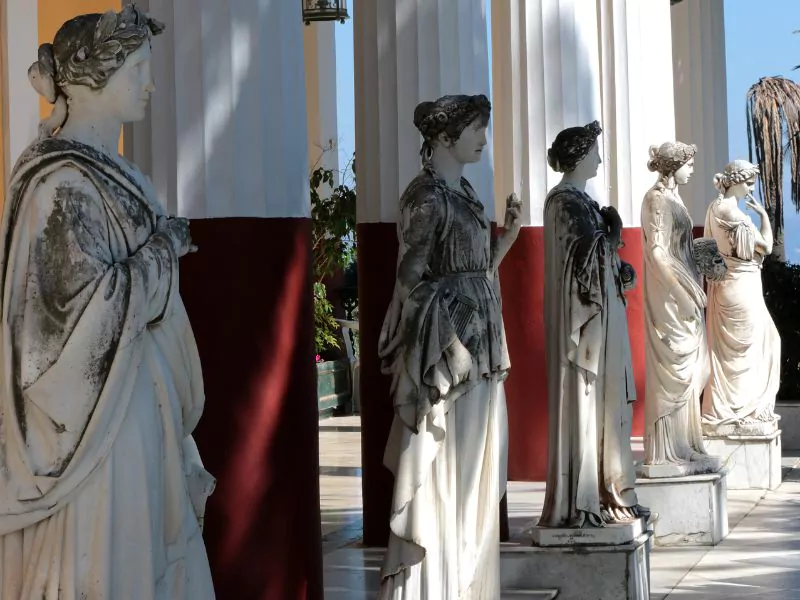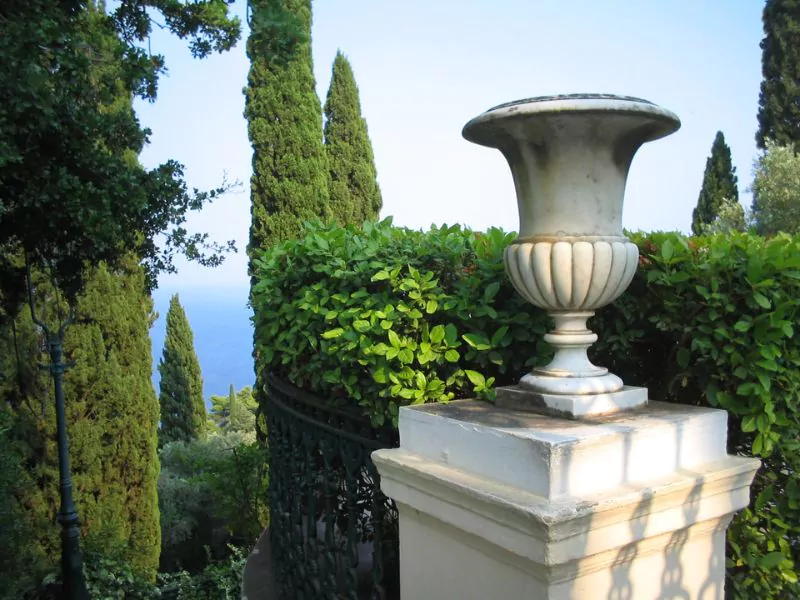The Achilleion Palace includes many highlight exhibits, each with its unique features some of which are Dying Achilles, Peristyle of the Muses, Achilleion Museum, The Achilleion Museum and Gardens of the Achilleion.
Table of Contents
Dying Achilles

The Dying Achilles is an emblematic marble statue nestled in the verdant gardens of Achilleion Palace. Crafted by Ernst Herter, a renowned German sculptor, the statue encapsulates the tragic end of the Greek hero, Achilles. Struck by Paris’s arrow, the fallen hero is depicted in an evocative pose that captures his last breath.
The statue stands as a testament to Herter’s ability to convey profound emotion and narrative through stone. The attention to detail, from the intricate carvings on Achilles’ shield to the pain etched on his face, is remarkable. This iconic piece of art has become synonymous with the Achilleion Palace and is among Greece’s most recognized works of art.
Situated in the palace gardens, the Dying Achilles is set against the backdrop of flourishing flora and the sparkling Ionian Sea. The statue’s dramatic pose paired with its picturesque setting creates a captivating visual spectacle for visitors.
It’s not just a symbol of Achilles’ demise, but also a representation of the palace’s historical significance and its deep-rooted connection to Greek mythology.
Peristyle of the Muses

The Peristyle of the Muses is another awe-inspiring feature of the Achilleion Palace. This colonnade, situated on the palace’s south terrace, is adorned with statues of the nine Muses of Greek mythology. Each muse, crafted meticulously, represents a different sphere of the arts and sciences, encompassing everything from history and music to astronomy and epic poetry. The colonnade is a tribute to the indomitable spirit of creativity and learning in ancient Greece.
In addition to its artistic merit, the Peristyle of the Muses offers breathtaking views of the Ionian Sea. The combination of the muses’ statues, reflecting the sunlight, and the panoramic sea views create a serene and contemplative setting. This blend of art, history, and nature makes the Peristyle a must-see for any visitor to the Achilleion Palace.
Achilleion Museum
The Achilleion Museum, housed within the main palace building, is a treasure trove of historical artifacts. The museum showcases a vast array of exhibits, from the lavishly adorned staterooms that once served as the living quarters for Empress Elisabeth of Austria and Kaiser Wilhelm II, to an extensive collection of paintings, sculptures, and other artifacts. These pieces collectively narrate the palace’s rich history and its royal occupants’ lives.
The museum also offers a deep dive into the aesthetics of royal life during the time. The ornate decorations, grand furniture, and exquisite artworks reflect the opulence of the era. Each room in the museum has a unique story to tell, making a visit to the Achilleion Museum akin to stepping back in time.
Gardens of the Achilleion

The gardens of the Achilleion are a paradise in their own right. As one wanders through these lush landscapes, it becomes clear that they are just as impressive as the palace itself. The gardens are home to a variety of sculptures, fountains, and other features, all inspired by Greek mythology. This creates a dreamy atmosphere where visitors can immerse themselves in the legends of ancient Greece while surrounded by natural beauty.
From the meticulously manicured hedges to the aromatic flower beds, every element of the garden has been designed with care and precision.
The garden’s setting, overlooking the sea and the surrounding countryside, adds to its charm. The Gardens of the Achilleion offer a tranquil retreat where visitors can admire the blend of art, mythology, and nature.
Achilles Triumphant

The Achilleion Palace’s theme is centered around Achilles, the legendary Greek hero. The statue of the Dying Achilles and the Peristyle of the Muses are just some examples of this theme. However, there is one more notable feature that further solidifies this connection – “Achilles Triumphant.”
This impressive sculpture stands in front of the palace entrance, depicting a triumphant Achilles holding the slain Hector’s body. It is a powerful representation of victory and revenge, showcasing Achilles’ strength and resilience in the face of adversity.
The sculpture serves as a reminder of the palace’s overarching theme and adds to its historical significance.
The Triumph of Achilles

One of the crowning artistic features of the Achilleion Palace is a vivid wall painting by renowned Austrian artist Franz Matsch. The painting dramatically depicts Achilles’ victory over Hector during the Trojan War, a pivotal moment in Greek mythology.
Matsch, with his masterful strokes, captures the raw intensity of the duel, the valour of Achilles, and the tragic end of Hector. The juxtaposition of the triumphant hero and the fallen antagonist against the backdrop of the war-torn city of Troy creates a striking visual narrative.
This painting, much like the sculptures of Achilles within the palace, reinforces the enduring presence of the Greek hero throughout the palace and further adds to the richness of its mythological and historical tapestry.
The Apotheosis of Achilles
Another remarkable work of art in the Achilleion Palace is the wall painting “The Apotheosis of Achilles” by Franz Matsch. This painting vividly depicts the ascension of Achilles to Mount Olympus, the home of the gods in Greek mythology.
Matsch’s virtuosic use of color and form brings this climactic moment to life, as Achilles, draped in divine robes, ascends towards the heavens. The painting conveys not just the physical act of ascension, but also the metaphysical journey of a mortal being elevated to the status of a god.
As with his other works in the palace, Matsch’s painting of Achilles’ apotheosis reinforces the palace’s overarching theme, adding another layer of depth to its rich and visually stunning exploration of Greek mythology.
The painting serves as a testament to Matsch’s artistic genius and his ability to capture the essence of mythological narratives in his works.
The Imperial Staircase

The Imperial Staircase is a truly magnificent sight to behold within the Achilleion Palace. This grand staircase, leading up to the palace’s staterooms, exudes an air of regality and grandeur that encapsulates the palace’s imperial past.
The staircase is a masterful blend of architectural prowess and artistic embellishment, with its ornately carved banisters and intricate frescoes lining the walls.
As visitors ascend the steps, they are met with a visual journey that transports them back to the times of Empress Elisabeth and Kaiser Wilhelm II, echoing the lavish lifestyles of these past inhabitants. The Imperial Staircase, in all its spectacular grandiosity, serves not only as a functional feature of the palace but as a symbol of this historical dwelling’s royal heritage.
The Throne Room
The Throne Room stands as the epitome of royal extravagance within the Achilleion Palace. Regarded as the most lavishly decorated room in the palace, it is an embodiment of imperial grandeur and opulence.
The highlight of this room is a majestic throne, meticulously crafted from pure gold and ivory, which once served as the seat of Empress Elisabeth and Kaiser Wilhelm II. The throne’s intricate design and precious materials are a testament to the meticulous craftsmanship and superior artistic taste of the period.
The room itself is adorned with rich tapestries, grand chandeliers, and an array of priceless artefacts, each adding to its aura of magnificence. The Throne Room, in all its resplendent glory, offers visitors a glimpse into the regal lifestyles of the palace’s past inhabitants, making it an unmissable stop on any Achilleion Palace tour.
Wrapping Up
The Achilleion Palace, with its spectacular architecture, captivating art, and opulent interiors, offers a unique glimpse into the grandeur of the past. Each room, each sculpture, and each painting tells a story, immersing visitors in the mythology and history that shape this remarkable edifice. From the serene Gardens of the Achilleion to the majestic Imperial Staircase and the resplendent Throne Room, the palace provides a feast for the senses. The overarching theme of Achilles, encapsulated in Franz Matsch’s dramatic wall paintings, adds a layer of depth to the experience, creating a profound connection between the palace and the rich tapestry of Greek mythology. Indeed, a visit to the Achilleion Palace is a journey through time, a journey that leaves one with an enduring sense of awe and admiration for the transcendent beauty of the past.